It's a problem every fencer with long hair (and in fencing this means everything that is not a pixie...) knows: what in heaven's name are you supposed to do with your mop under a fencing mask? This is way more than a questions of good or bad looks, since at some competitions the wrong hairdo might even put you at risk of a yellow card! We've teamed up with our Instagram girl Johanna, who has first-hand experience of the issue, to give you a round-up of the rules and the best strategies to tame your hair.
What's the best hairdo for fencing? My real-life approved solutions
Horse-riding in my childhood, fencing in my twenties…it seems like whenever I pick up a sport, there is a kind of headgear involved. Which you could call somewhat unfortunate, since my hair has always been shoulder-length or even longer (proof of its state nowadays is to be found on our
Instagram account, where you might sometimes spot my red strands, or in our features for the
FIE fashion show). This means that ever since I was a kid I had to face the question: How do you fit all that under a helmet or a mask? (I should probably consider myself lucky that I never thought seriously about swimming…).
Whereas riding was relatively straight forward – just follow the example of your mount and wear a ponytail (unless you’re into classical dressage, but let’s not split hairs now ;) ), fencing turned out to be trickier.
In fact, I may unwittingly have fought my very first fencing competition with what a referee would call “chevelure non-conforme”, or hair not conforming to the rules, since my hair looked like this:
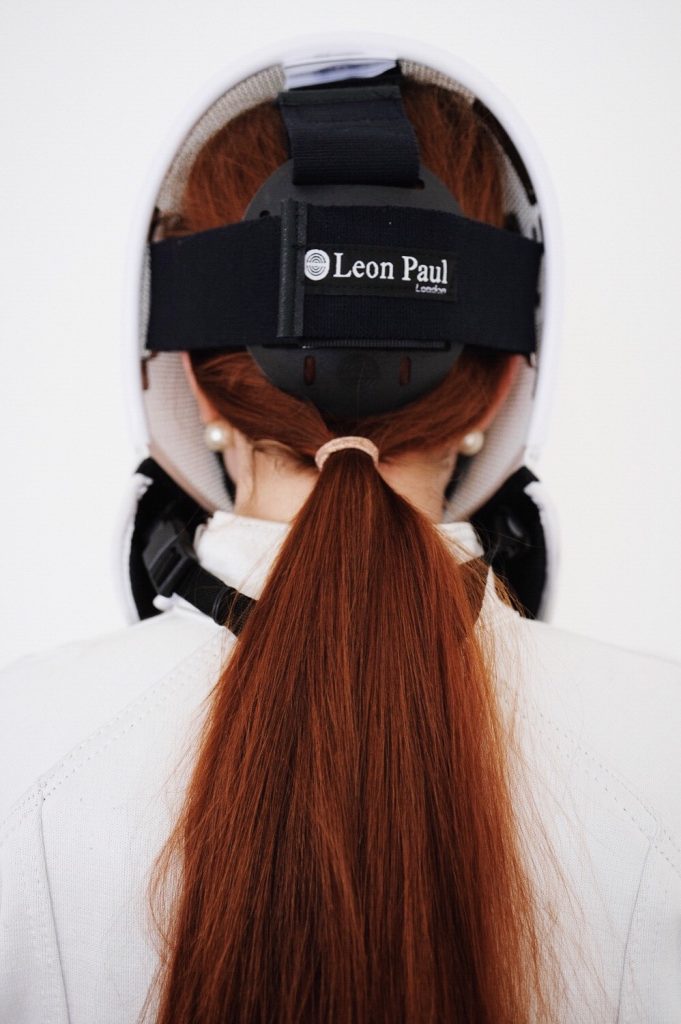 A normal ponytail does NOT conform to the FIE rules about hair :( (Picture © Leon Paul)
A normal ponytail does NOT conform to the FIE rules about hair :( (Picture © Leon Paul)
Luckily, it was a small regional tournament and since it was epee, nobody really cared about hair, but technically I could have been given a yellow for this hairstyle, which was completely unsuited for a competition. (Probably as unsuited as my fencing skills at the time, but that’s a different story).
As a matter of fact, the rules of the FIE are pretty explicit on hair, since section T 115 of the
technical rules dedicates a whole paragraph to the hairdo you should sport on the piste.
It reads as follows:
Before the start of the bout, the fencers' hair must be fastened and placed inside the clothing and/or mask in such a way as to ensure that:
- it does not cover a valid surface (and thus prevent a hit from being scored).
- it does not conceal the name and nationality of the fencer.
- it does not need to be put back in place during the bout, thus interrupting it.
In the case of violation of this rule, the referee will apply the penalties for group 1 offences. (t.158-162, t.165, t.170)
And infact, in the table in t. 170 you’ll find “hair non-conforming to the rules” as one of the reasons to be given a yellow card (or even a red one, in case you already have precedents).
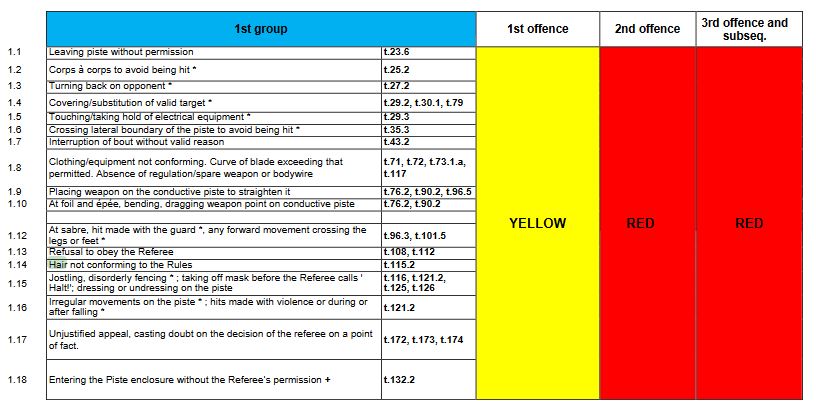 t. 170 of the FIE rulebook features an overview over all offences and their respective cards. In picture: First-group offences
t. 170 of the FIE rulebook features an overview over all offences and their respective cards. In picture: First-group offences
So congratulations, with my low ponytail I ticked all the boxes of what you should not do with your hair in a fencing competition.
Luckily, I’ve studied the rulebook since then and gained a lot more experience… not only in fencing, but also about how to fasten long hair without risking to be given cards from even the most meticulous of referees. Here’s the hairstyles I’ve found to work best.
And for full disclosure: I am usually a friend of an untamed mane and, unless for fencing and other sporting activities, hardly ever wear my hair up. Which means that the hairstyles here should be fool-proof!
The base for all the hairstyles is the usual low ponytail I’ve been sharing my sporting life for almost three decades now (I guess some things just never change ;) ). This also comes in very handy if you’re wearing a
mask with the Contour-Fit fastening system, since that’s what Leon Paul recommends being worn with that kind of fixation.
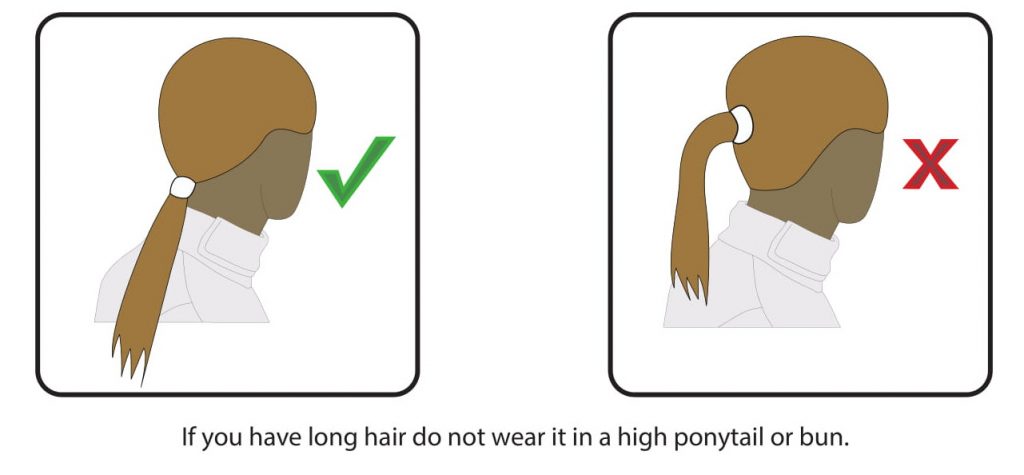 Leon Paul mask care instructions (Picture © Leon Paul)
Leon Paul mask care instructions (Picture © Leon Paul)
Having this said, if you prefer the
traditional mask fastening system featuring a metallic tongue, what I’ve also seen (and tried) is a high ponytail-loop slightly off to the side, which can go between the tongue and one side of the mask (I’d recommend the side of your non-weapon arm for this) and will be held in place by the mask backstrap. If your hair is very long - mine at the moment is just two inches from reaching my waist - you will have to combine this with a loop (see below my instructions for the low bun), or otherwise your hair will still flow down your back, which is obviously not the purpose here.
 A high ponytail (here with loop, since my hair is too long) can work even with Leon Paul's Contour fit system (but it'll never bee my personal favourite)
A high ponytail (here with loop, since my hair is too long) can work even with Leon Paul's Contour fit system (but it'll never bee my personal favourite)
Unless you have very thick hair, this is a style you can in theory also use with the
Contour Fit disk, but I’ve just found it unnecessarily complicated, since this kind of hairstyle requires adjustments every time you take your mask on and off. As long as you don’t have to stop in the middle of a bout, you’ll be fine card-wise (before the ref says “allez”, you have the right to put your hair in place), but in my eyes it’s just a bit too much of a hassle… especially since the new backstrap introduced with to the
FIE rules update in 2018 is there. In fact, with this backstrap being less elastic than its predecessor, it’s become harder to pull your hair through the “hole” between tongue/contour fit disk and the side of the mask, which is the reason why I prefer the low ponytail no matter what kind of mask fastening system I am wearing. I am just too lazy (and maybe a bit too concerned about the wellbeing of my mane) to undergo this ordeal every time ;).
(Last but not least, if your high ponytail has a tendency to come out uneven in length - which as a matter of fact is kind of unavoidable if your hair, like mine, is cut straight-across and not layered - you have to be extra vigilant to form the loop right, or the ends might come loose while you're fencing. See also my remarks in the comments.)
So, back to the fencing hairdos based on a low ponytail. As I said before, this needs some tweaks to be competition-safe. The easiest way is obviously to just tuck your ponytail into the collar of your
fencing jacket, but depending on the thickness and/or curliness of your hair, this might not work well. Plus: at least with my kind of hair (long and straight) it tickles. So no, thank you, this is not for me.
I prefer to go with the following two variants, for which you won’t need more than hair ties. (Dealing with bobby pins every time before practice, would be a nightmare for me. As I said, when it comes to my hair I’m a lazybones.)
Just one word of advice: make sure you always use good, strong hair ties that won’t wear out quickly. I personally love the ones that look like old telephone cables: they keep their shape very well, and if ever they lose it, just pour boiling water over them (I would never have expected it, but this really works!) and they will regain their original shape.
The wrapped braid
This hairdo, which requires just two hair ties, can even be seen on some fencers competing at international level.
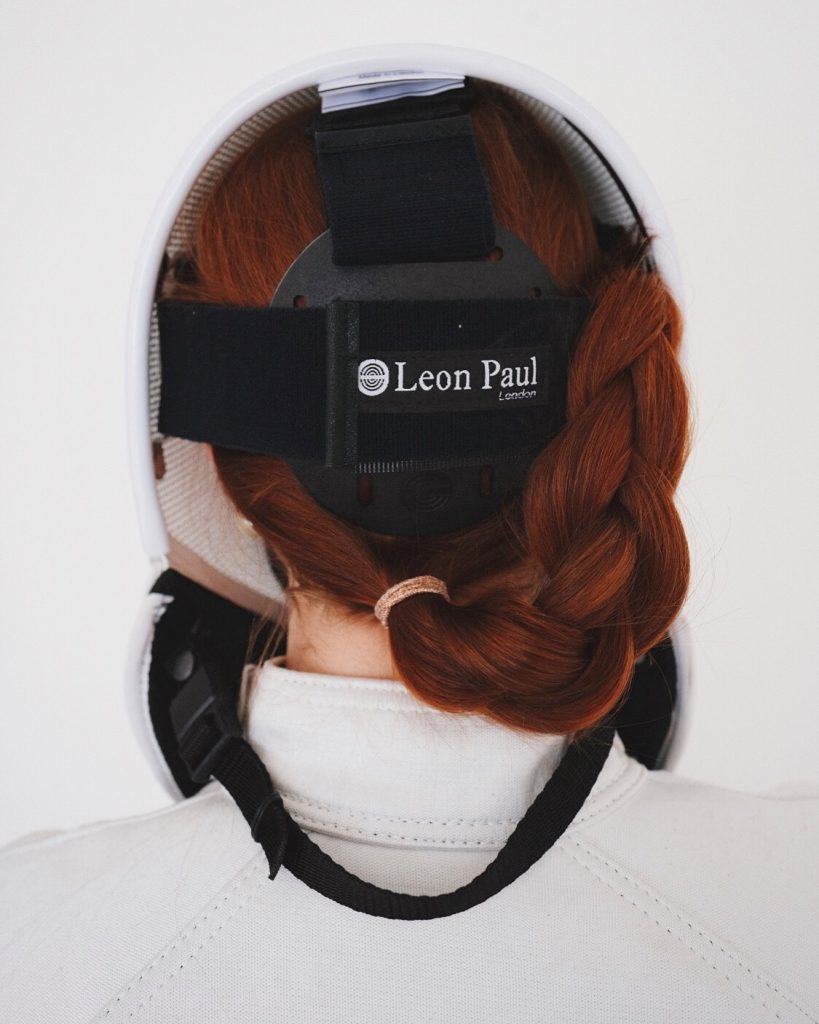 A braid tucked in/wrapped around the mask backstrap - a neat solution for long hair (Picture © Leon Paul)
A braid tucked in/wrapped around the mask backstrap - a neat solution for long hair (Picture © Leon Paul)
Instructions: Fasten your hair in a low ponytail secured by an elastic, then braid it and secure the end with another elastic. Then, every time you put on your mask, wrap the braid around your
mask backstrap (how many times will depend on the length of your hair), and you’re good to fence. This hairstyle is easy to realise, competition-safe and can even be done with a French braid basis, if you have very thin and “slippery” hair that always manages to escape even the tightest hair ties. It has, however, the same inconvenient as the afore-mentioned high ponytail: it requires constant attention, in the sense that you have to adjust it every time you take your mask off and on.
The twisted low bun
My personal favourite – easy, fast and low maintenance: adjust it once before the pools, and then forget about your hair the rest of the day.
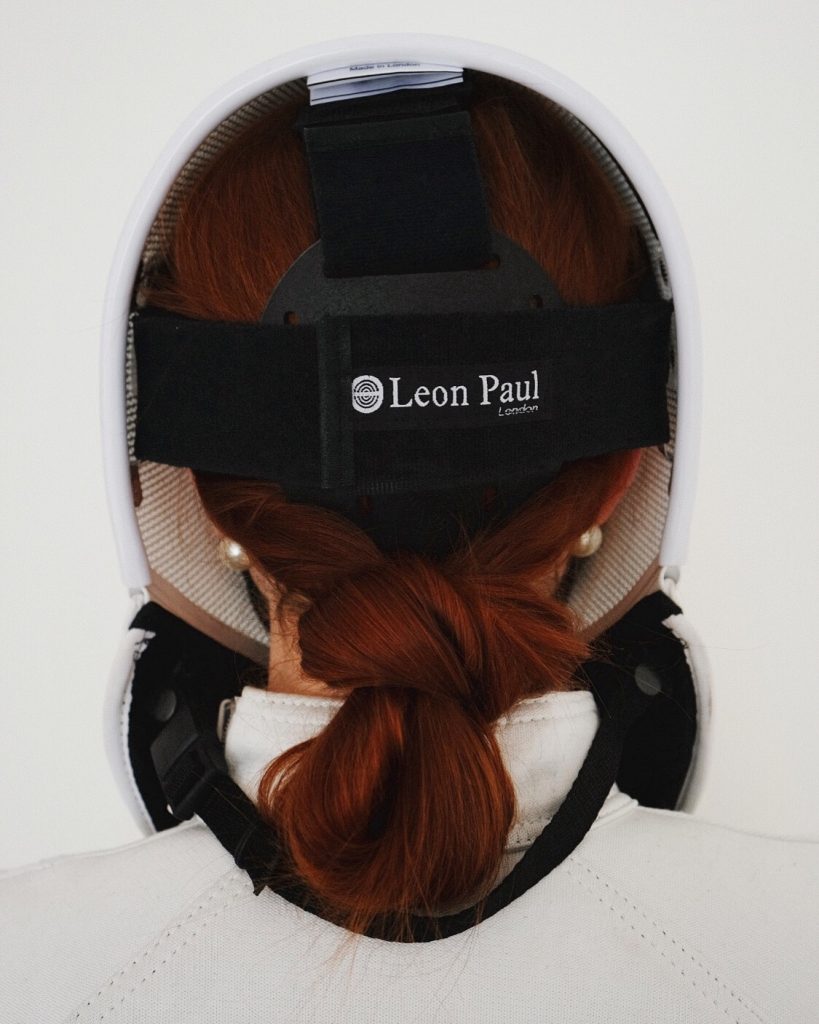 The look once you're finished (Picture © Leon Paul)
The look once you're finished (Picture © Leon Paul)
Instructions:
Fasten your hair as if you were to tie a low ponytail, but don’t pull it completely through the hair tie when fastening, thus creating a loop. Tuck the ends of the ponytail - the ones that don’t form the loop, that is – into the hair-tie, and that’s it.
In epee, I've never had problems with this hairdo (especially not when I added the extra hair ties to make the "hair package" even smaller), but if you want to go 100% safe for foil fencing, where flicks on the back might indeed be more common, then you can tuck the "loop" into the collar of your fencing jacket. Since the ends are kept in place by the hair tie, at this point you shouldn't have to worry about tickling anymore (I cannot guarantee that this is 100% the same for very curly hair, but for straight to wavy hair you should be safe from tickling).
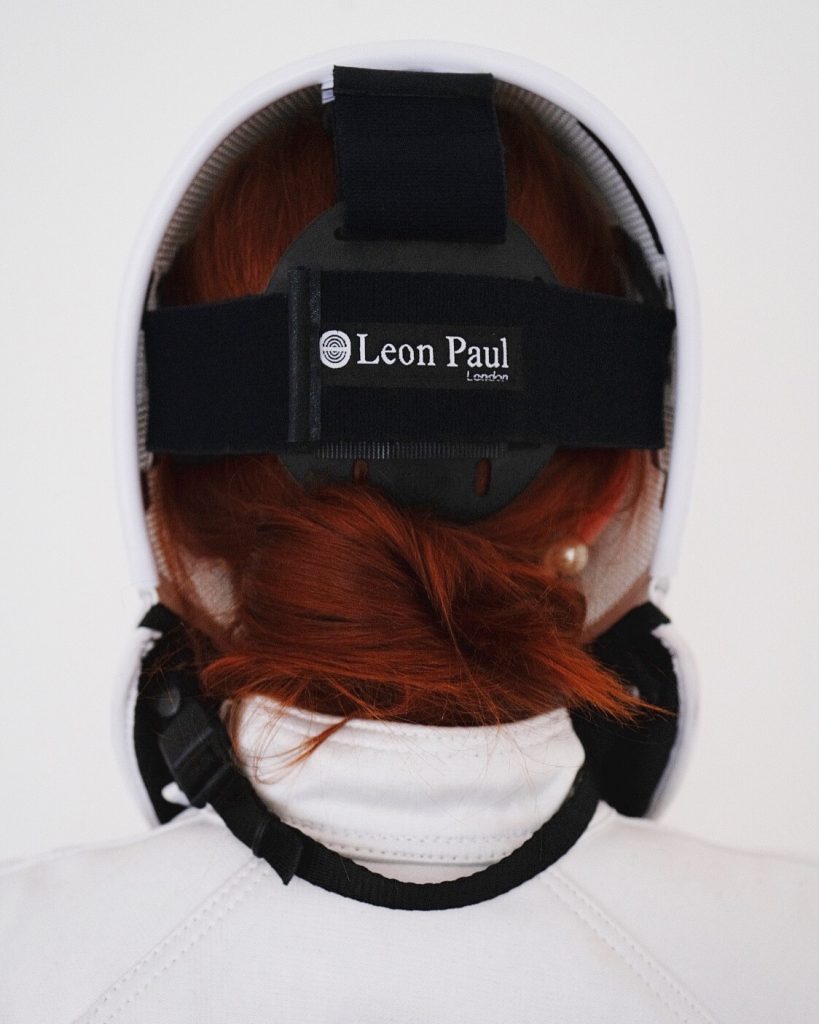 All tucked in for an extra neat look (Picture © Leon Paul)
All tucked in for an extra neat look (Picture © Leon Paul)
For extra safety and to make the hair package even smaller (so that it won't get in the way of the
safety backstrap that comes with the
Contour fit systems), you can add one or two extra hair ties for competitions, but even with only one hair tie this hairstyle withstands a complete training routine. If you wish, and to hold even the slipperiest strands in place, you can upgrade this hairstyle by doing with a (French) braid as base, but whether this is necessary of not will depend on your type of hair. For me, the “basic” version usually is largely sufficient... and no matter whether it's for training or for competitions you won't spot me in a fencing hall with "cheveux non-conformes" ever again.
Kind of a reassuring proof to the saying that sometimes as you grow older, you also grow wiser. Now I just have to hope for the same degree of wisdom when it comes to my tactics on the fencing piste...
 A normal ponytail does NOT conform to the FIE rules about hair :( (Picture © Leon Paul)
A normal ponytail does NOT conform to the FIE rules about hair :( (Picture © Leon Paul) t. 170 of the FIE rulebook features an overview over all offences and their respective cards. In picture: First-group offences
t. 170 of the FIE rulebook features an overview over all offences and their respective cards. In picture: First-group offences Leon Paul mask care instructions (Picture © Leon Paul)
Leon Paul mask care instructions (Picture © Leon Paul) A high ponytail (here with loop, since my hair is too long) can work even with Leon Paul's Contour fit system (but it'll never bee my personal favourite)
A high ponytail (here with loop, since my hair is too long) can work even with Leon Paul's Contour fit system (but it'll never bee my personal favourite)  A braid tucked in/wrapped around the mask backstrap - a neat solution for long hair (Picture © Leon Paul)
A braid tucked in/wrapped around the mask backstrap - a neat solution for long hair (Picture © Leon Paul) The look once you're finished (Picture © Leon Paul)
The look once you're finished (Picture © Leon Paul) All tucked in for an extra neat look (Picture © Leon Paul)
All tucked in for an extra neat look (Picture © Leon Paul)
